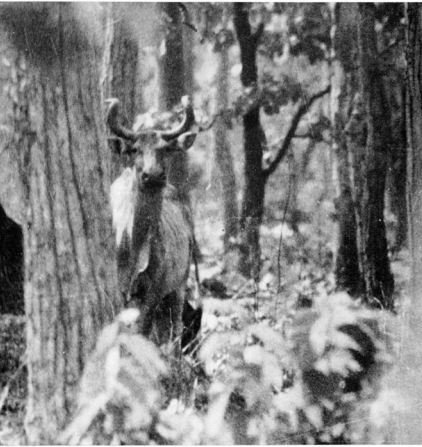Bos sauveli Urbain, 1937
Kouprey, Grey ox, Indo-Chinese forest (archaic), Kouproh (archaic)
Taxonomy & Nomenclature
Synonym/s: Bibos sauveli Urbain, 1937; Novibos sauveli Urbain, 1937; Bos javanicus sauveli Urbain, 1937
Conservation Status
Extinct
Last record: 1969; 1986 (Fisher & Blomberg, 2012)
IUCN RedList status: Critically Endangered (Possibly Extinct)
It is commonly stated that the last sighting of a Kouprey (Bos sauveli) was in 1983, but this almost certainly refers to a possible sighting in July 1982 as reported by (Thornback, 1983), the previous year (Peter Maas pers. comm., March 2012). No reports have been confirmed after 1969, although their number and veracity suggests that the species survived for at least a decade after the last known record. The species apparently always existed in very low population densities (Thornback, 1983), which would have predisposed it to extinction. Some hope is held out for its continued existence, as its distribution may have extended into neighbouring countries such as Laos PDR, but the few expeditions mounted to rediscover it have all failed to find it (e.g. Timmins, 2011) and it is most likely now extinct.
Distribution
Cambodia
Anatomy & Morphology
Body mass: 791.32kg (Wimberly, 2023:SI:10)
Biology & Ecology
Hypodigm
USNM 361392 (Wimberly, 2023:SI:6)
USNM 399379 (Wimberly, 2023:SI:6)
Media
Many photos of wild killed kouprey can be seen here: https://www.facebook.com/%E0%B8%81%E0%B8%B9%E0%B8%9B%E0%B8%A3%E0%B8%B5-Bos-sauveli-Kouprey-577681802319226/
Vincennes Zoo specimen (1937-1940)
The first of two known captive animals, and the holotype of the species, was held by the Vincennes Zoo (Paris). French veterinarian Dr. René Sauvel was largely responsible for this, sending it to his friend Achille Urbain who was the head of the zoo, and the latter provided the scientific description of the species named in honour of Dr. Sauvel (Urbain, 1937). There are at least eight known photographs of the individual (photos 1 to 8), with the fourth possibly being rediscovered by the Instagram user animalpic_post. I have also come across the first photo (photo 1) which was described as an "antelope" but looks like the young bull as he arrived at the zoo in his crate in April 1937 (film and photo are dated 2 days apart, but probably relate to the same day). This has been backed up Melanie Nayyal, who has found that the banteng with which it might otherwise be confused with arrived at the zoo in a following year, and that the Kouprey did arrive in April 1937 (Urbain et al., 1939). Subsequently, a film depicting the young Kouprey and the gaur arriving at the zoo was brought to my attention by Andrew Vamvatsikos.
Film of the Vincennes Zoo specimen arriving (5 May 1937)
Above: Film brought to my attention by researcher Andrew Vamvatsikos.
Photos of the Vincennes Zoo specimen (7 May 1939-1940)
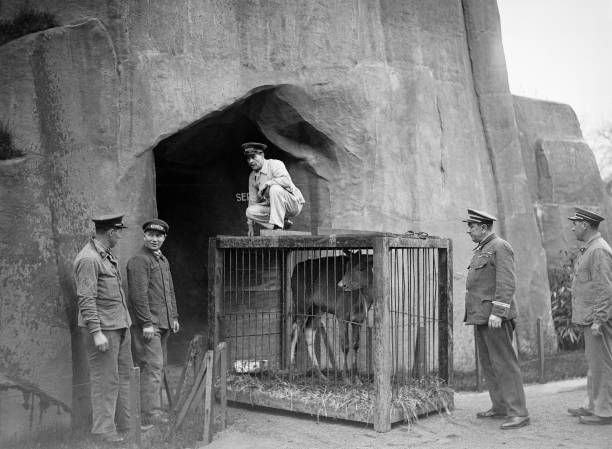
Above: a photo of the young bull as he arrived at the zoo on 7 April 1937. Keystone-France. Source: Getty Images.
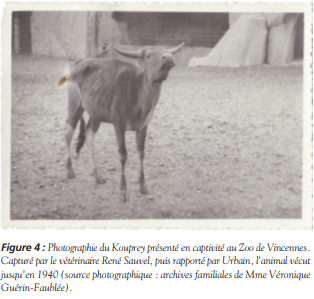
Source: Borrel (2014:341), but first published by (Urbain, 1937a)
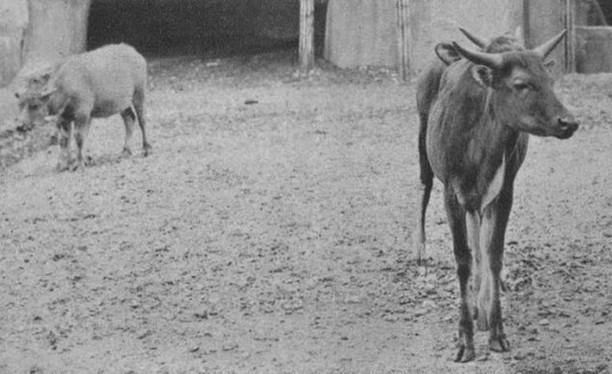
Above: an old postcard ("Kouprey d'Indochine"). Source: https://www.zoovenirs.fr/jscripts/gallery2/main.php?g2_view=core.DownloadItem&g2_itemId=83123#page=8
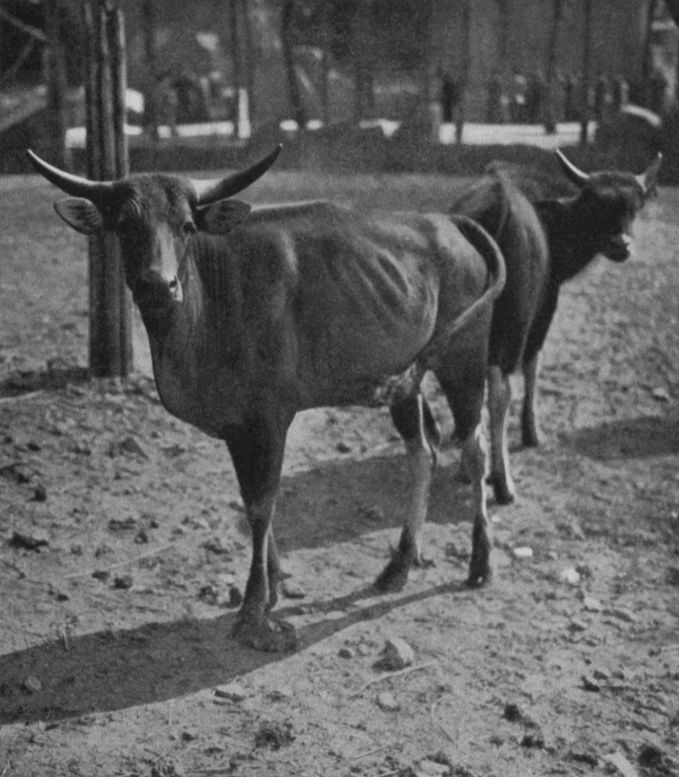
Above: a newly discovered historical photo, found by Instagram user animalpic_post.
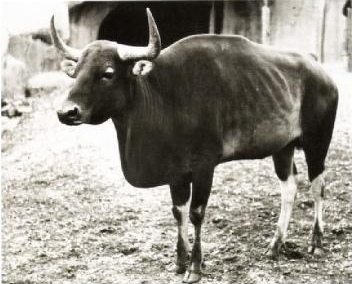
Source: McGeown (year?)
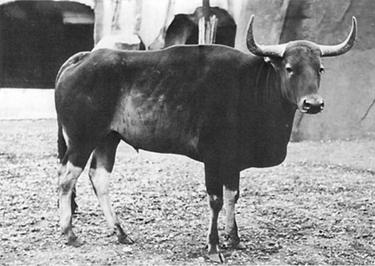
Above: photograph by Georges Broihanne in 1937. First published by (Urbain et al., 1939). Source: https://en.wikipedia.org/wiki/File:Kouprey_at_Vincennes_Zoo_in_Paris_by_Georges_Broihanne_1937.jpg
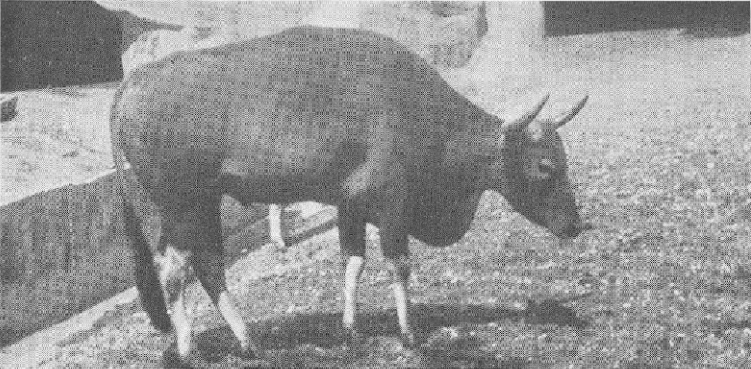
Above: photographer unknown. Source: Edmond-Blanc (1947).
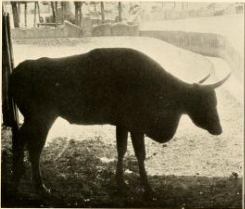
Above: silhouette of the holotype, taken by François Edmond-Blanc in June 1939. Source: Coolidge, 1940.
Film of wild kouprey herd (1951 or 1952)
"You are now seeing the complete version of the only known footage of Koupreys, taken from the documentary "Wild Cattle of Cambodia", by Dr. Charles Heizer Wharton in 1957, from several of his footages during an expedition to Cambodia in 1951":
The full documentary:
Wild female (1968)
Other videos
References
Original scientific description:
Urbain, Achille. (1937a). Le kou prey ou boeuf gris cambodgien. Bull. Soc. Zool. Fr. 62(5): 305-307.
Other references:
Anonymous. (1964). A preliminary list of rare mammals including those believed to be rare but concerning which detailed information is still lacking. IUCN Bulletin 11(Special Supplement): 4 pp.
Anonymous. (1985). Choosing the 24 most Endangered Species. Species Survival Commission Newsletter 5: 17-23.
Bacon, Anne-Marie et al. (2018). A rhinocerotid-dominated megafauna at the MIS6-5 transition: The late Middle Pleistocene Coc Muoi assemblage, Lang Son province, Vietnam. Quaternary Science Reviews 186: 123-141. [Abstract]
Bohlken, Herwart. (1961). Der Kouprey, Bos (Bibos) sauveli Urbain 1937. Zeitschrift für Saugetierkunde 26: 193-254.
Borrel, Thierry Antoine. (2014). Achille Urbain (1884-1957), Le Premier Directeur du Parc Zoologique de Paris. Bull. Acad. Vét. France 167(4): 335-348. [includes an early photo of the Vincennes Zoo specimen]
Coolidge, Harold Jefferson. (1940). The Indo-Chinese forest ox or kouprey. Mem. Mus. Comp. Zool. 54(6): 421-531.
Cox, R., Laurie, A. and Woodford, M. (1992). Report of the results of four field surveys for kouprey (Bos sauveli) in Viet Nam and Lao. P.D.R. Unpublished report, Kouprey Conservation Trust.
Dioli, M. (1995). A clarification about the morphology of the horns of the female kouprey. A new unknown bovid species from Cambodia. Mammalia 59: 663-667.
Duval, Mathieu, Fang, Fang, Suraprasit, Kantapon, Jaeger, Jean-Jacques, Benammi, Mouloud, Chaimanee, Yaowalak, Iglesias
Cibanal, Javier, and Grün, Rainer. (2019). Direct ESR dating of the Pleistocene vertebrate assemblage from Khok Sung locality, Nakhon Ratchasima Province, Northeast Thailand. Palaeontologia Electronica 22.3.69 1-25.
Edmond-Blanc, Francois. (1947). A Contribution to the Knowledge of the Cambodian Wild Ox or Kouproh. Journal of Mammalogy 28(3): 245-248. https://doi.org/10.2307/1375175
Ellerman, J. R., and T. C. S. Morrison-Scott. 1951. Checklist of Palaearctic and Indian mammals 1758 to 1946. Trustees of the British Museum (Natural History), London, 810 pp.
Enderlein, P. (1976). Report from the second expedition to the Dongrak Mountain range in eastern Thailand in search for Kouprey ( Bos sauveli). FAO Regional Office for Asia and the Far East. Bangkok.
Filoux, Arnaud et al. (In Press, 2015). A Pleistocene mammal assemblage containing Ailuropoda and Pongo from Tham Prakai Phet cave, Chaiyaphum Province, Thailand. Geobios. doi:10.1016/j.geobios.2015.07.003 [Abstract]
Fisher, Diana O. and Blomberg, Simon P. (2012). Inferring Extinction of Mammals from Sighting Records, Threats, and Biological Traits. Conservation Biology 26(1): 57-67. https://doi.org/10.1111/j.1523-1739.2011.01797.x
Fisher, Diana O. and Humphreys, Aelys M. (2024). Evidence for modern extinction in plants and animals. Biological Conservation 298: 110772. https://doi.org/10.1016/j.biocon.2024.110772
G. J. Galbreath, J. C. Mordacq, F. H. Weiler. (2006). Genetically solving a zoological mystery: was the kouprey (Bos sauveli) a feral hybrid? Journal of Zoology 270(4): 561-564.
G. J. Galbreath, Mordacq, J. C. & Weiler, F. H. (2007). An evolutionary conundrum involving kouprey and banteng: a response from Galbreath, Mordacq and Weiler. Journal of Zoology 271: 253-254.
Gray, T. N. E., Ou, R., Huy, K., Pin, C. and Maxwell, A. L. (2012). The status of large mammals in eastern Cambodia: a review of camera trapping data 1999-2007. Cambodian Journal of Natural History 2012(1): 42-55. [failed to record the Kouprey]
Grigson, C. (2007). Compex cattle: some anatomical observations on the possible affinities of the kouprey: a response to Galbreath et al. (2006). Journal of Zoology 271: 239-241.
Hassanin, Alexandre and Ropiquet, Anne. (2004). Molecular phylogeny of the tribe Bovini (Bovidae, Bovinae) and the taxanomic status of the Kouprey, Bos sauveli Urbain 1937. Mol. Phylogenet. Evol. 33: 896-907
Hassanin, Alexandre and Ropiquet, Anee. (2007a). What is the taxonomic status of the Cambodian banteng and does it have close genetic links with the kouprey? Journal of Zoology 271: 246-252.
Hassanin, Alexandre and Ropiquet, Anne. (2007b). Resolving a zoological mystery: the kouprey is a real species. Proc. R. Soc., B 274(1627): 2849-2855.
Hassanin A., Ropiquet A., Cornette R., Tranier M., Pfeffer P., Candegabe P., Lemaire M. (2006). Has the kouprey (Bos sauveli Urbain, 1937) been domesticated in Cambodia? C. R. Biologies 329(2): 124-135. [Abstract]
Hedges, S. Groves, C. P. Duckworth, J. W. Meijaard, E. Timmins, R. J. Burton, J. A. (2007). Was the kouprey a feral hybrid? A response to Galbreath et al. (2006). Journal Of Zoology 271(3): 242-245.
Hendrix, S. (1995). Quest for the Kouprey. International Wildlife Magazine, Sep/Oct.
Heng Kimchhay, Ouk Kimsan, Kry Masphal, Sin Polin, Uch Seiha and Weiler, H. (1998). The distribution of tiger, leopard, elephant and wild cattle (gaur, banteng, buffalo, Khting Vor and kouprey) in Cambodia. In: Interm Report: July 1998 (ed.), Wildlife Protection Office. Phnom Penh, Cambodia.
Hoffmann, Robert S. (1986). A new locality record for the kouprey from Viet Nam, and an archaeological record from China. Mammalia 50(3): 391-395.
Holmes, Branden. (2021). What's Lost and What Remains: The Sixth Extinction in 100 Accounts (eBook). Self published.
Jones, K. E., Bielby, J., Cardillo, M., Fritz, S. A., O’Dell, J., Orme, C. D. L., Safi, K., Sechrest, W., Boakes, E. H., Carbone, C., et al. Pantheria: a species-level database of life history, ecology, and geography of extant and recently extinct mammals: Ecological archives e090-184. Ecology 90, 9 (2009), 2648–2648.
Joslin, Paul and Maryanka, Daphne. (1968). Endangered Mammals of the World: Report on Status and Action Treatment. IUCN Publications, New Series, Supplementary Paper No. 13: 34 pp.
Kemf, E. (1988). Fighting for the Forest Ox. New Scientist 30: 51-53.
Laurie, A., Ha Dinh Duc and Pham Trung Anh. (1989). Survey for kouprey (Bos sauveli) in Western Daklak Province, Vietnam. Unpublished report IUCN and The Kouprey Conservation Trust.
Lee, T. E., Fisher, D. O., Blomberg, S. P. and Wintle, B. A. (2017). Extinct or still out there? Disentangling influences on extinction and rediscovery helps to clarify the fate of species on the edge. Global Change Biology 23(2): 621-634. https://doi.org/10.1111/gcb.13421
Lekagul, Boonsong. (1952). On the trail of the Kouprey or Indo-Chinese Forest Ox (Bibos sauveli). Bombay Natural History Society 50(3): 623-628.
Lemoine, Rhys Taylor, Buitenwerf, Robert, Faurby, Sören and Svenning, Jens-Christian. (2025). Phylogenetic Evidence Supports the Effect of Traits on Late-Quaternary Megafauna Extinction in the Context of Human Activity. Global Ecology and Biogeography 34(7): e70078. https://doi.org/10.1111/geb.70078 [Supporting Information: Data S1]
Leslie, David M. Jnr. and Schaller, George B. (2009). Bos grunniens and Bos mutus (Artiodactyla: Bovidae). Mammalian Species 836: 1-17.
MacKinnon, J. R. (1986a). Bid to save the Kouprey. WWF Monthly Report, 1986(April): 91-97.
MacKinnon, J. R. (1986b). Kouprey status survey. Unpublished report.
MacKinnon, J. R. and Stuart, S. N. (eds.). (1989). The Kouprey: An Action Plan for its Conservation. IUCN/SSC Asian Wild Cattle Specialist Group. ISBN: 2-88032-972-8.
McGeown, Patrick. (year?). The Kouprey. Living (year?): 30-31.
Neese, H. C. (1976a). The Kouprey (Bos sauveli). Report on survey in southern Laos. Unpublished report.
Neese, H. C. (1976b). Kouprey clues and Rhino news. Wildlife 18(9): 40-41.
Orollette, Dan Jnr. (2013). Gold Rush in the Jungle: The Race to Discover and Defend the Rarest Animals of Vietnam's "Lost World". Crown. 336 pp.
Parkinson, D. A. (1982). On the trail of the Kouprey. WWF Monthly Report December 1982. WWF, Switzerland.
Pfeffer, P. (1969). Considérations sur l'écologie des forêts claires du Cambodge oriental. Terre et Vie. 1: 3-24.
Pfeffer, P. and Kim-San, O. (1967). Le Kouprey, Bos (Bibos) sauveli Urbain, 1937; discussion systematique et statut actuel. Hypothese sur i'origine du Zebu (Bos indicus). Mammalia 31(4): 521-536. [Abstract]
Sauvel, V. (1949). Distribution geographique du Kou-Prey (Bibos sauveli Urb.) Mammalia 13(4): 144-148.
Scott, Peter (ed.). (1965). Preliminary List of Rare Mammals and Birds, pp. 155-237. In: The Launching of a New Ark. First Report of the President and Trustees of the World Wildlife Fund. An International Foundation for saving the world's wildlife and wild places 1961-1964. London: Collins.
Sinding, Mikkel-Holger S. et al. (2021). Kouprey (Bos sauveli) genomes unveil polytomic origin of wild Asian Bos. iScience 24: 103226.
Sitwell, N. (1970). Is this the rarest animal in the world? Animals 13(7): 306-307.
SSC Wild Cattle Specialist Group Report (1982). Draft recommendations for the conservation of the Kouprey in Thailand. Mimeo.
Suraprasit, Kantapon et al. (In Press, 2020). Taxonomic reassessment of large mammals from the Pleistocene Homo-bearing site of Tham Wiman Nakin (Northeast Thailand): relevance for faunal patterns in mainland Southeast Asia. Quaternary International. https://doi.org/10.1016/j.quaint.2020.06.050 [Abstract]
Thornback, Jane. (1983). Wild cattle, bison and buffaloes: their status and potential value. Gland, Switzerland: The IUCN Conservation Monitoring Centre.
Thouless, Chris. (1987). Kampuchean wildlife - survival against the odds. Oryx 21(4): 223-228, figs. 1-3
Timmins, R. J. (2011). Searching for the Last Kouprey. Report to the Critical Ecosystem Partnership Fund. [No town given]: CEPF.
Timmins, R.J., Hedges, S. and Duckworth., J.W. (2008). Bos sauveli. In: IUCN 2011. IUCN Red List of Threatened Species. Version 2011.1. . Downloaded on 26 June 2011.
Urbain, Achille. (1937b). Le Kouprey ou Boeuf sauvage du Cambodge. Mammalia 1: 257-258.
Urbain, Achille. (1939). Note compémentaire sur le Boeuf sauvage du Cambodge (Bos (Bibos) sauveli Urbain). Bull. Mus. Nat. Hist. Nat., 11 : 519-520.
Urbain, Achille, Rode, P. and Pasquier, Μ. Α. (1939). La collection de Bovinos asiatiques du Pare Zoologique du Bois de Vincennes. Mammalia 3: 122-125.
Wharton, C. H. (1957). An ecological study of the Kouprey (Novibos sauveli). Monographs of the Institute of Science and Technology, Manila, Philippines, Monograph 5: 1-107.
Wharton, C. H. (1968). Man, fire and cattle in Southeast Asia. Proceedings of the Annual Tall Timbers Fire Ecology Conference 8: 107-167.
Wimberly, Alexa N. (2023). Predicting body mass in Ruminantia using postcranial measurements. Journal of Morphology 284(10): e21636. https://doi.org/10.1002/jmor.21636 [Supporting Information]
Winker, J. (2004). "Bos sauveli" (On-line), Animal Diversity Web. Accessed June 12, 2012 at http://animaldiversity.ummz.umich.edu/site/accounts/information/Bos_sauveli.html
WWF (1982). World's oldest wild cattle sighted in Southeast Asia. World Wildlife Fund News 19: 8.
WWF (1982). World's oldest wild cattle believed rediscovered in Southeast Asia, landmines hamper search. World Wildlife Fund News Release 12/82. Gland, Switzerland.
Vietmeyer, N. (1983). Little-known Asian animals with a promising economic future. National Academy Press, Washington, D.C.
http://www.cepf.net/Documents/Final_SG_GWC_Searching_for_the_Last_Kouprey.PDF
http://globalwildlife.org/our-work/regions/asia/searching-for-the-last-lost-kouprey/
https://www.eco-business.com/news/the-kouprey-on-the-trail-of-cambodias-elusive-wild-cattle/
<< Back to the Cetartiodactyla (Even-toed Ungulates) database

